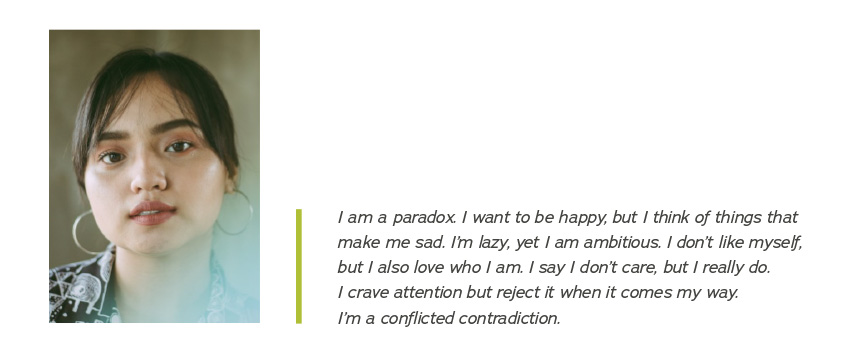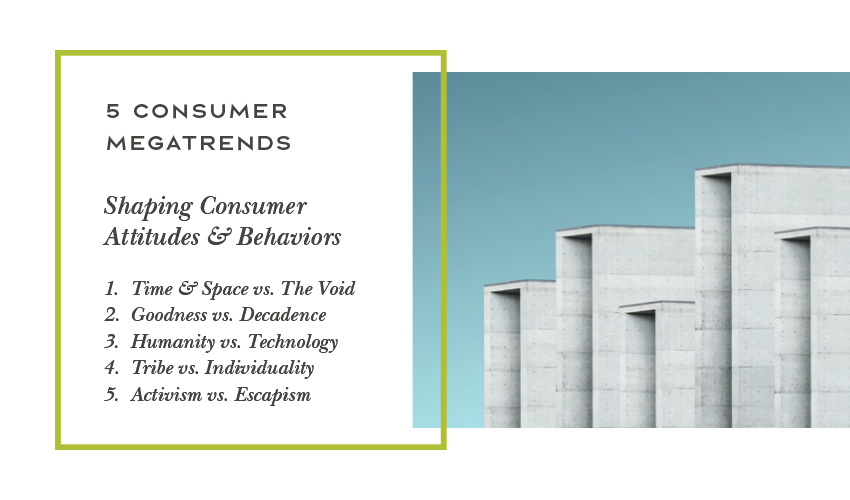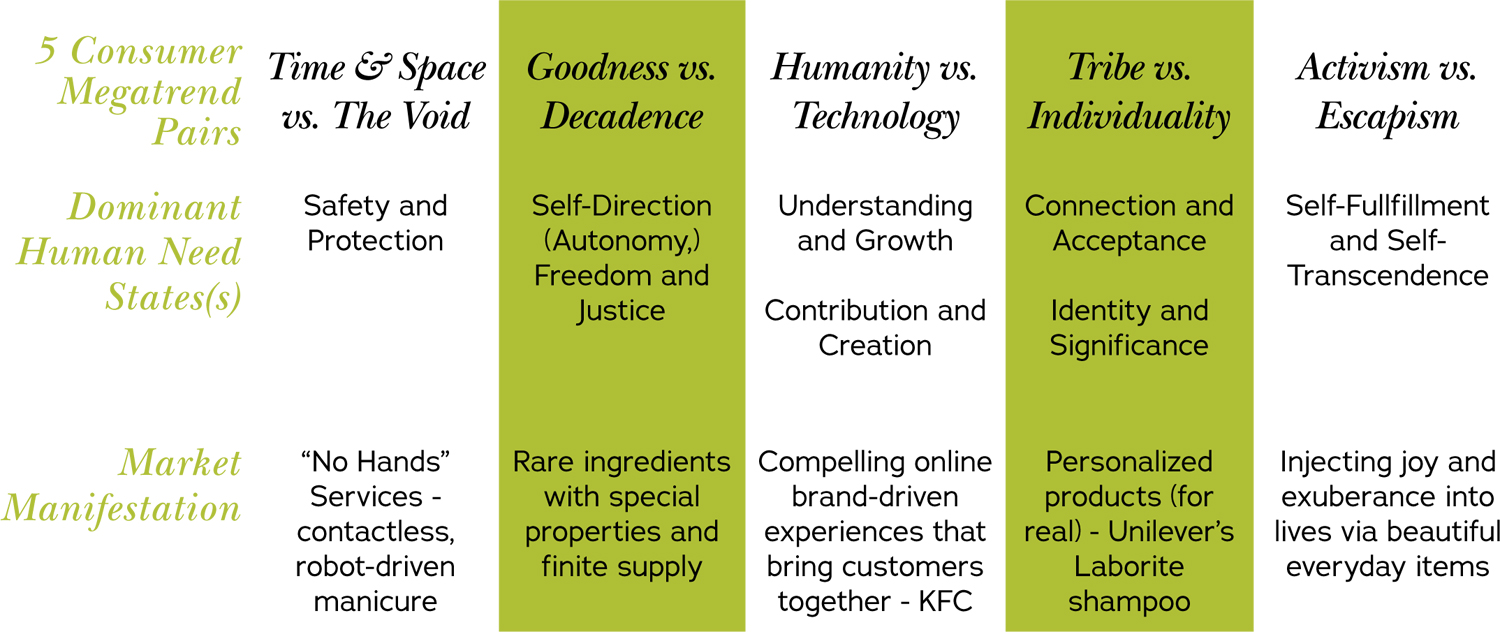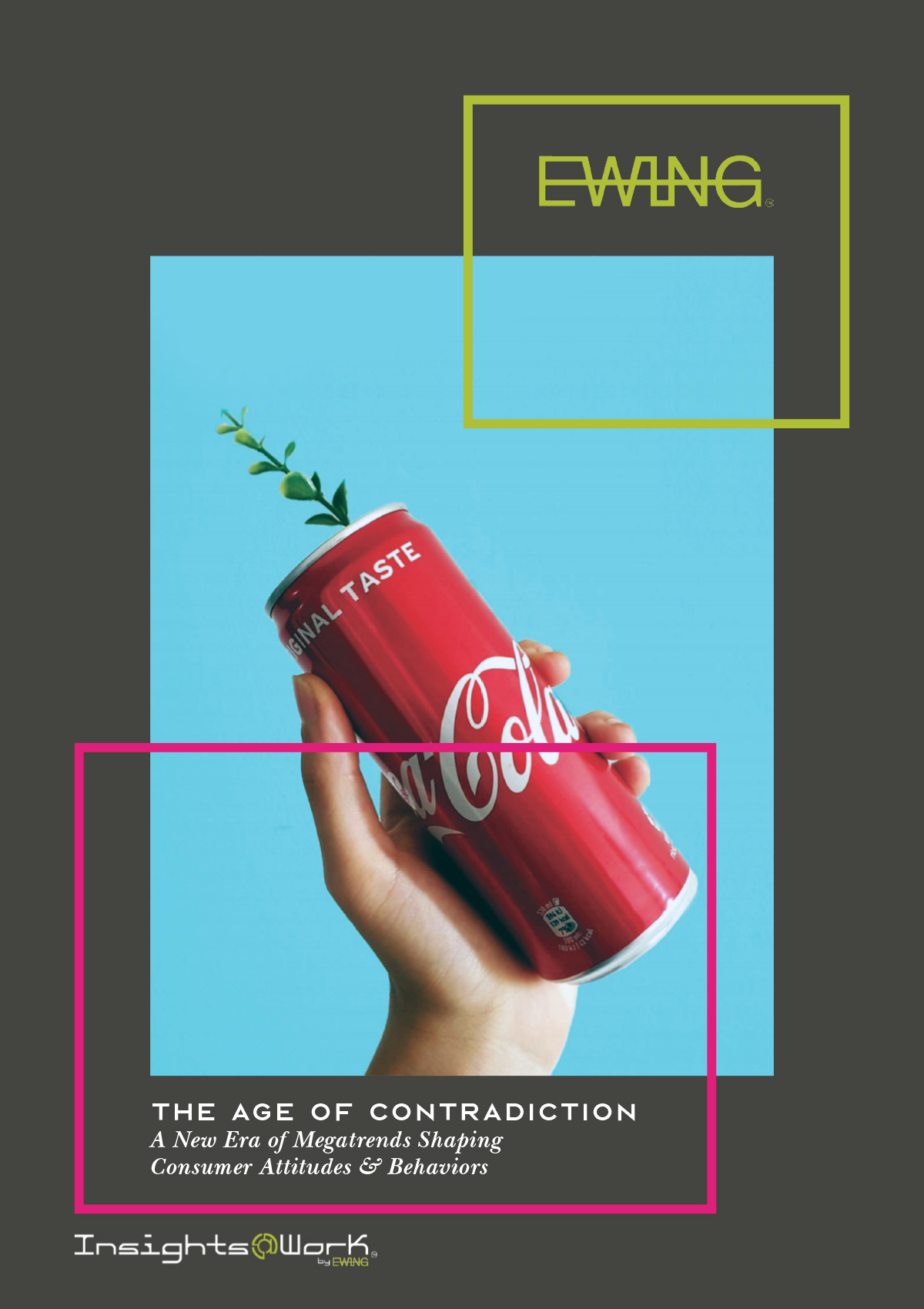The Age of Contradiction A New Era of Megatrends Shaping Consumer Attitudes & Behaviors
The Age of Contradiction
We are in an age of acute contradiction. Unrivaled prosperity and technology advancement is accompanied by fierce political and social unrest and reaction. We are standing at a crossroads between innovation and tradition. Moreover, the year 2020 heralded a dramatic break between the world’s past and future. Many people are looking excitedly ahead, but just as many are staring backward.
Against this backdrop, we bring you the Age of Contradiction, EWING’s megatrend program designed to power years of growth and innovation by providing a market-centric, consumer needs–aligned framework for business growth and transformation driven by product, service, and experience innovation.
We hope that our research report inspires thought as much as challenges it. We believe understanding the Age of Contradiction will be necessary for brands to successfully navigate the forces shaping our future.
With joy,
K. Heimerl
Founder, EWING Innovation
Methodology
In the early 2000s, EWING’s founder, K. Heimerl, began charting the long-term global consumer megatrends that would shape the decades forward.
The first megatrends program formally released in 2005 captured the forces shaping consumer attitudes and behavior to 2020. The fundamental megatrends fueled new product introductions—including numerous category leaders—for the world’s largest consumer product companies over nearly two decades.
But 2020 ushered in a new era and a need to revisit the forces shaping consumers to 2030 and beyond. Introducing the Age of Contradiction borne of rigorous secondary research across continents and myriad diverse sources. The insights center on one massive concept—contradiction—supported with 5 megatrend pairs that standalone and work together to elucidate the paradoxical consumer behavior that will dominate the global landscape in the years ahead.
Heimerl learned early in her career that trends and opportunities emerge “on the fringes” at unexpected times, from unexpected sources, in unexpected places. Her approach to insight capture is aggressive, global, and multidisciplinary, and enables rapid identification and application of breakthrough ideas. By “casting the net wide” and expertly connecting the dots among seemingly disconnected things, she and her team are able to help clients to not only see a future world that is perceived accurately but also help them to create market-winning products and services in anticipation of that future.

Contradiction Equals Balance
Minimalist vs. maximalist, open vs. closed, good vs. evil, artificial vs. natural—these are seeming opposites of each other with sharp contrast in both meaning and outcome. Yet it is here, in these contrasts, that we find the threads of connection that lay bare the bold, bald, frequently painful beauty within humanity.
Yes, it is amidst contradiction where we find balance. Where we find ourselves. And where we find the richest opportunity for business and product innovation.
In a contemporary world where clashes and conflict couple with grace and harmony, consumers are exploring and embracing their contradictions and inviting manufacturers to do the same by demanding products and services that feed their contradictions.
Consumers are asking themselves—and their leaders—to consider contrast as a means for deeper exploration of both future possibilities as well as emotional ones. It’s as if we are—individually and collectively—jarring ourselves on purpose in order to keep hammering home the balance that is, inevitably, happening now before our very eyes and ears.
Embracing contradiction is the work of our times—and the fundamental opportunity for product innovators.
Come, explore the elements of contradiction with EWING that enable new product innovation and reveal new opportunities for many years to come . . .

The Age of Contradiction


Megatrend 1
The global pandemic changed us. Space and place are more important than ever. We want to control our surroundings—both in the home and out.
We want both “nothing” experiences alone (to shut down, switch off) as well as rich, full, positive experiences alone and with others.
These contrasting megatrends are about space – our physical surroundings—but they are also, critically, about the energy that is given or taken and our desire to control it.
Time and Space vs. The Void are as much about creating and enhancing the various environments in which we live, work, and play as they are about masking or obliterating them.
The fundamental human need underscoring the Time and Space vs. The Void megatrend is safety and protection.
The Essence & Trajectories
As consumers increasingly seek comfort and security, there is a corresponding renewed focus on older traditions centered on heritage and nostalgia. And the cycle of nostalgia is becoming shorter as consumers yearn for the not-so-distant past. We don’t have to look back decades for the opportunities; we only have to look back a few years, and for many, simply pre-2020.
As the lines between fact and fiction blur, consumers will increasingly engage in gut-led decision-making. The implications? Brand—and the emotional aspects of brand— become paramount.
If the UN’s prediction is correct, the human population will reach 8.5 billion by 2030. Implication? Consumers and communities will seek to maximize the space—and, importantly, the quality perception of it—that remains after development.
Emerging needs include:
- Creating a protective shield against bugs, viruses, microbes, people, dirt, noise, ugliness, unsavory smells, nastiness, work, and so on
- Creating “nothing” experiences and environments—a personal bubble, a sanctuary, protection, and self-care
- Resurrection of and immersion into that which brings comfort—scents, places, and things
- Adoption of rituals that add structure and consistency to our lives, as well as a perfectly timed “pause”
- All-out armor to our senses, creating a barrier to the world
- Corresponding to the need for nothing experiences will be an increased demand for slowness. Yes, slow—not fast—will become an ideal state for consumers who will turn away from chaos and speed. The creates opportunities for “slow” products (e.g., thick, creamy, slow pouring) that give a nod to the original slow movement—i.e., “Slow Food.”
- “Manufacturing” our in-home environment (and other “owned” environments) to meet our energy needs
- Creating carefully curated spaces that signal to others who we are or who we aspire to be, fostering connection and acceptance
- Mindfully selecting external/out-of-the-home environments that meet our energy needs
- Increased primacy of feeling connected to our surroundings and those around us
- Frequenting shopping spaces that increasingly become multisensory, social sanctuaries as the lines between work and social lives continue to blur
Would you like to learn more about this megatrend pair, including additional trajectories, global market manifestations, emerging trends and opportunities, and how to apply them to fuel your business growth and transformation?
Contact EWING to schedule your customized Age of Contradiction event.
info@GrowWithEwingCo.com
Megatrend 2
The conflict between good and evil is a universal part of the human condition. There are several variations on this conflict, including the fight between individuals or ideologies, with one side held up as Good, while the other is portrayed as Evil. Another variation is the inner struggle between good and evil.
Both variations are playing out in contemporary society today.
Good government and accountable political and corporate leadership are qualities that many consumers have taken for granted. However, today moral collapse and state failure are new potential realities for the most stable economies across the globe.
Consumers are fed up for a variety of reasons. Not only do they have rights they want protected, but they also want to be a part of something bigger.
Consumers are fighting now, more than ever, for what they believe in, including a broadening focus on human rights and development of more local social enterprises. It’s the strive for “goodness”—in its various meanings and forms, depending on the individual, their life experience, and their worldview.
But before consumers can demand ethics of leaders and institutions, they must demand it of themselves first. Individual behaviors today are just as unsavory as institutional and collective behaviors.
Consumer’s external finger-pointing in the near term will give rise to internal soul-searching in the long term—a phenomenon that must occur for true change and transformation to occur.
“Goodness” for the consumer in the short term means a focus on their personal health and wellness. Long term, it means a shift from “me” to “we” as consumers increasingly realize that humanity—and the world—functions best as a “we.”
The Essence & Trajectories
With so much hurt and destruction in the world, humans do not have much interest in caring for each other at this time, but they do demonstrate great interest in caring for things that can’t hurt them—like pets and plants and the environment.
In rapidly growing numbers, people around the planet are waking up to the awareness and importance of biophilia—the innate human instinct to connect to and benefit from nature and other (non-human) living beings.
This awareness married with increasing populations driving down the presence of natural, naturful spaces to accommodate them and driving up smaller and smaller living spaces is fueling not just growth in pets, pet care, gardening and plant care; it is also fueling growth of nature-borne and nature-inspired products for self and home.
But paradoxically, as we protect, honor, and admire finite resources on the one hand, with equal measure we destroy them voraciously on the other hand to fuel our self-interests and desires.
It is this very contradiction that sits at the center of the Goodness vs. Decadence megatrend.
Emerging Trends Drive Innovation Opportunities
Slowly we’ll see a change in consumer spending from private exclusivity to public utility, from outward social status to inward journey, and poorly made mass-produced products to a true appreciation of creative and artisan values, and a genuine quality, durable product.
Climate change is forcing consumers to take a closer look at consumption habits and will change consumer opinions about the value of goods and services.
With consumers’ more mindful approach to spending on the horizon, they will desire products that are more authentic and unique to them.
Product ingredients perceived as “rare specimens” are on the rise—i.e., exclusive access, “live” ingredients or those with a short life span, or “only here” geographies.
Would you like to learn more about this megatrend pair, including additional trajectories, global market manifestations, emerging trends and opportunities, and how to apply them to fuel your business growth and transformation?
Contact EWING to schedule your customized Age of Contradiction event.
info@GrowWithEwingCo.com
Megatrend 3
While many of us have prepared ourselves for the greatest changes ahead as a byproduct of the coupling of humanity and technology, many others have not, choosing instead to turn away from the massive shifts that will dramatically alter not just our society and economy but our principles and our biology.
Although we are not entirely there yet, one of the fundamental issues we will face is how we preserve our humanity in a world that is rapidly beginning to resemble that of science fiction.
Will we blindly outsource and relinquish aspects of our lives to the global-tech companies? Or will we take back the reins and demand a balance between technology and humanity?
The answer is starting to emerge—albeit slowly and sporadically. Today while most consumers are still in the throes of their love affair with technology without pausing to fully think through the long-term ramifications of their behaviors or of technology itself, many others are starting to push back—to embrace and amplify all that makes humans human. All that makes us great.
Each of us will strike our own balance of humanity vs. technology to the extent we are able, but the momentum behind technology is sure to create a force that gains a life of its own.
The focus in the years ahead for manufacturers must be on delivering value-added solutions through technology in both the physical and digital worlds.
Emerging Trends Drive Innovation Opportunities
While natural, clean, and organic have dominated the landscape for years, we’ll see an emergence of entirely new values rooted in what’s fabricated—not what’s real—influenced by artificial intelligence, synthetic enhancements, and virtual experiences.
“Beyond experiences” will take center stage in the years ahead such as digital aromas, touchscreens that convey shape and texture, and digital malls that allow consumers to use all five senses when shopping.
And while consumers will seek digital multisensory experiences on the one hand, consumers will also look for real, physical sensory experiences on the other.
In the near term, this desire for 360-degree sensory stimulation creates a host of opportunities for product manufacturers to build enhanced multisensory effects and experiences into their products. Going one step further, they can create “wrap around” value to the core product in the form of experiences and services that get as close as possible to the 360-degree target. This is the next evolution of delivering increased immersiveness, which also aids in delivering against the core consumer desire to control and/or mask their surroundings.
Experiences that Feel Real—Experiences (i.e., “experiential” tactics) diminished to a mere marketing tool or fad are no longer sufficient for consumers—they want real, true emotional connections to brands. This creates opportunities ahead for brands to create technology based experiences as well as compelling offline experiences that bring their customers together and build powerful, emotional brand connections.
One thing is clear: there are certain things technology cannot deliver. As a result, we will see a premium placed on human skills like creativity and compassion. The brands that can successfully embody these traits ahead will win in the global marketplace.
Would you like to learn more about this megatrend pair, including additional trajectories, global market manifestations, emerging trends and opportunities, and how to apply them to fuel your business growth and transformation?
Contact EWING to schedule your customized Age of Contradiction event.
info@GrowWithEwingCo.com

Megatrend 4
There is no question that where we live and the places in which we work and play influence who we are. Winston Churchill once said, “We shape our buildings; thereafter they shape us.” This idea extends to our cities, neighborhoods, and places.
As we shape our communities through material changes and social experiences, so we define its identity; in turn, as backdrops for life and centers for community and activity, these places create and assemble our own individual and communal identities.
And so it goes with digital “spaces”—i.e., the places where people gather online also thread together our individual and communal identities.
But what happens when we remove humanity—the elements that make humans human— from the digital realm? When we eradicate face-to-face interactions? Human touch? Or create alter egos or avatars online to share not who we truly are, but who we aspire to be?
Do we come together in an open community? Break apart into closed tribes? Or splinter off entirely onto our own individual island?
We’re seeing each happen today as consumers increasingly embrace technology and integrate it into their lives. This creates opportunities for brands to build community, create powerful tribes, and empower individuality.
No doubt it is an exciting time for brands. But it is also a critical time that requires a great deal of responsibility and ethics to think through the ramifications of specific community-building, tribe-building, and individual-building efforts. What will the impact be on humans? On humanity? And on living everyday life in a world that is increasingly smaller, more crowded, and more diverse?
Will the tribalism of culture bubbles that don’t communicate together proliferate—e.g., the Hulu People, the Apple People? Will we behave more like computers—like extensions of algorithms ahead? All of this is possible ahead based on the choices we make individually, collectively, and organizationally today as we attempt to strike a balance between community and individuality.
Emerging Trends Drive Innovation Opportunities
Rise of Gutsy Individualism: We increasingly admire people who are unapologetically authentic. They are our modern heroes and heroines—i.e., profiles of courage and kindness, strength and nonconformity. What makes them iconic is being 100% themselves—e.g., Jasper Johns. Historically, brands have attempted to assume iconic people personalities as their own through partnerships and endorsements. But ahead we’ll see more and more brands embrace gutsy individualism themselves by creating brand personalities that stand alone and rise above the dull lull of commonality.
Ethics-Driven Individuals & Innovation: The brands that are embracing this practice today are angry, loud, and “in your face” and reflect our times of social unrest and general discord. This will shift ahead. Our global heroes and heroines will be those who temper their anger, despite a lifetime of pain, to personify the highest order values and ethics—e.g., tolerance, compassion, integrity, honesty, and inclusion. Likewise, brands that follow this route will be
the powerful brands of our future, and the powerful, most admired voices in our world. Ethics will once again take center stage and will meaningfully drive innovation ahead.
Rise of Communal Living: In the U.S., the share of adults who live alone nearly doubled over the last 50 years. Single-person households have become increasingly common in many countries across the world. And although people are more likely to live alone in affluent countries, rising loneliness—whether from living alone or from heavy use of technology that drives isolation—will give rise to communal living across the globe to combat loneliness.
Would you like to learn more about this megatrend pair, including additional trajectories, global market manifestations, emerging trends and opportunities, and how to apply them to fuel your business growth and transformation?
Contact EWING to schedule your customized Age of Contradiction event.
info@GrowWithEwingCo.com
Megatrend 5
The COVID-19 pandemic brought traditional means of protesting to a stop (sit-ins, rallies). However, new methods of nonviolent protesting surfaced that include physical, virtual, and hybrid forms. In short, the pandemic spawned not only new tools and new strategies for change but new motivations as well.
These activities have important impacts—not the least of which are to strengthen society and raise awareness of political and economic issues in critical need of change. Of course, some people have responded to the pandemic and government policies with defiance.
None of this is likely to subside anytime soon. But the upsurge in activism—and the exhausting negative emotions rising along with it—is driving a countertrend: escapism. This rise will propel consumer spending for years ahead as consumers seek comfort, control, and happiness.
Of course, technology is one beneficiary—specifically the rise in trial and engagement in immersive technologies like augmented and virtual reality. But we’ll continue to see escapism in the physical world as well, which creates innovation opportunities for manufacturers.
In the years ahead, consumers will teeter between aggressive activism and peaceful escapism as they attempt to bring to life their ideal vision of the world and society. They will regenerate from their activism by loading up on joyful, comforting activities and environments, then go back out and fight the good fight again and again.
This cycle will behave more like the tiny, ongoing sprints of the startup than the massive, sustained movements of the past.
Emerging Trends Drive Innovation Opportunities
Brand Activism: Brand Activism: Against a backdrop of widening inequality, social dislocation, and ethical complexity, market-winning brands will find ways to incorporate new views, values, and behaviors into their value propositions to help close the individual and societal gaps in identity, equality, data influence (advance or encroach), integrity, and social integration.
Everyday Exuberance: With a world in discord, consumers will increasingly seek “objects of beauty” to live with them and bring beauty to their everyday lives. This beauty extends to basic everyday items (read: shampoo, laundry detergent, home sprays, and repellants), which increasingly ahead will be packaged up and presented more beautifully than ever before.
Sum of the Small Things: Consumers are looking for things that make them feel like themselves again, that make life feel joyful again. Everyday consumables are a straightforward—and affordable—way to do that. Tiny joys that we curate to surround us in our home not only reveal our playful pursuits to others (social status/cred), but they also immerse us in our own individually designed “playground.” People need joy. People just want to be happy. Items that make them feel that way will be embraced.
Would you like to learn more about this megatrend pair, including additional trajectories, global market manifestations, emerging trends and opportunities, and how to apply them to fuel your business growth and transformation?
Contact EWING to schedule your customized Age of Contradiction event.
info@GrowWithEwingCo.com

Becoming a Future-Ready Organization
Is your organization thinking about undergoing a transformation such as developing new growth businesses outside your traditional core?
If so, think EWING. Our market and customer insights-driven innovation process is your practical and market-winning approach to business innovation.
We combine pioneering thought, market research, strategy, and design to build the most remarkable businesses and brands, infusing innovation where it matters most to propel your business forward:

All of these are firmly centered on one purpose: accelerating your growth and transformation.
Let us help you identify and tease out meaningful growth opportunities that improve your performance through innovation in products, services, processes, and business models.

